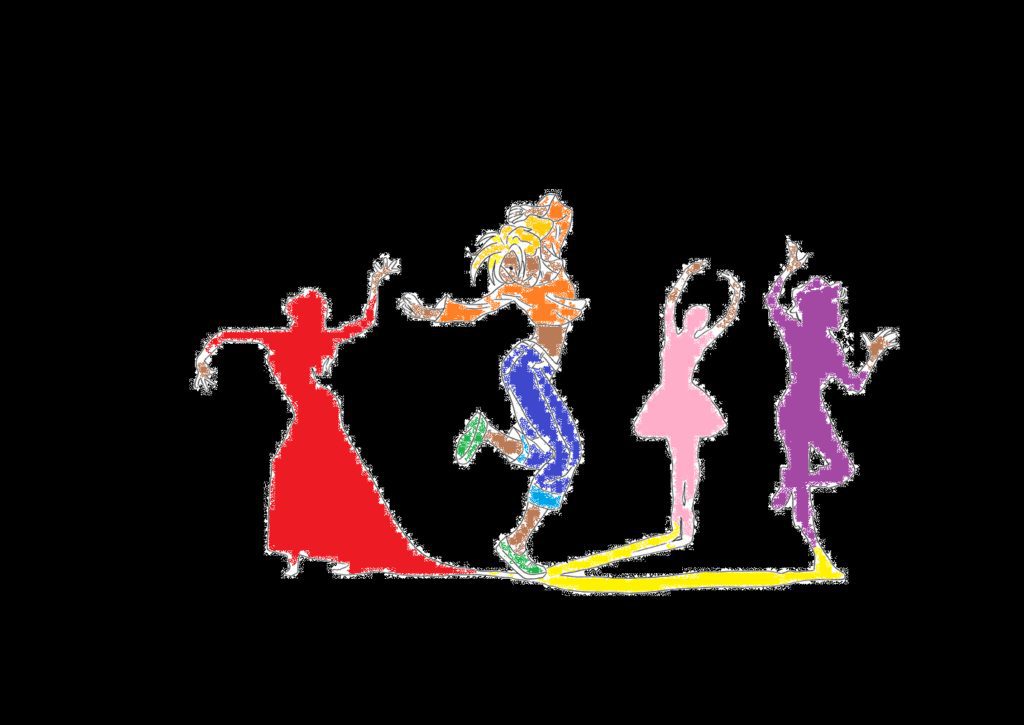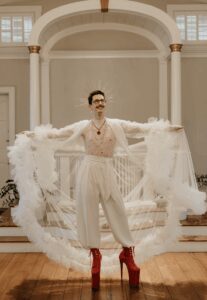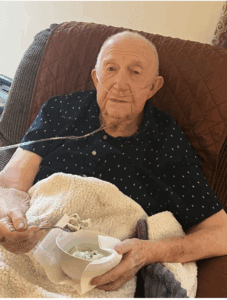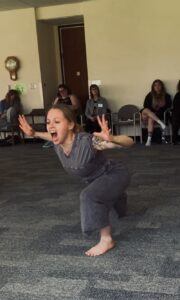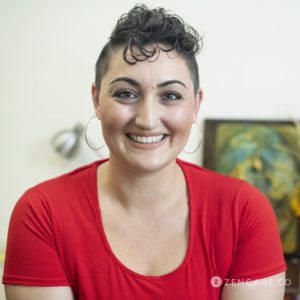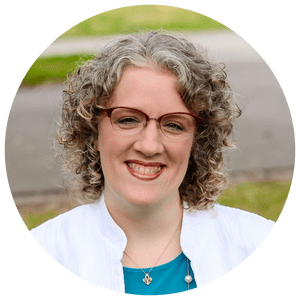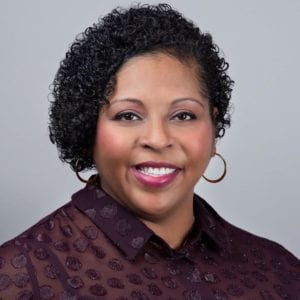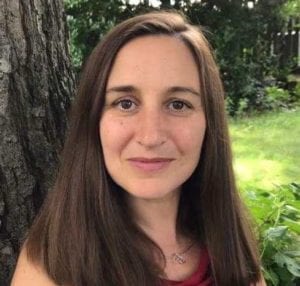What is dissociation? Apparently, it’s when you have the urge to say something, have a thought, or experience a feeling followed by the overwhelming sense that you don’t dare say, think, feel it, or otherwise show the external world because there will be TROUBLE! Or is it?
In early summer 2021, a call for participants to interview for a book project on dissociation appeared on my Facebook. The book is called Dissociation Made Simple written by Dr. Jamie Marich. As soon as I saw the call, as an individual with a physical disability, I KNEW I had to take part. Having followed the work of Jamie for years plus getting to know her as an individual, I was confident that my voice in the book would not become part of advertising simply because I was someone disabled doing something completely normal that really had nothing to do with being disabled. However, being disabled, I felt would offer a unique voice and perspective in the conversation to end the stigma around Dissociation and related disorders.
Admittedly, I’ve only had two personal encounters with anyone with DID and both were online. Unfortunately, one encounter involved someone bringing to my attention that they suspected I had DID, then accusing me of faking alters because “alters can’t possibly switch as much” as this person thought I was. In hindsight, what might have been happening is someone was noticing something that I was trying to ignore and push away, causing what appeared to be switching. Needless to say, my view and understanding of dissociation are somewhat limited and mildly terrifying, especially prior to any form of therapy for my own trauma. As I say that, I’m reminded of one particular conversation that sticks out in my mind when being asked by a friend if I knew what dissociation was. I responded “NO, why? Am I supposed to?” They replied “Interesting, you just gave the textbook definition.”
BACKSTORY
As a survivor of childhood trauma diagnosed with CPTSD, I was familiar with dissociation as a symptom of the larger diagnosis but never explored it much beyond that. Bringing up or trying to relate things from your trauma to your disability with an abled therapist is a challenge, especially considering my disability is from birth. Such forms of disability are often viewed as just life rather than recognized as something traumatic, more often than not resulting in having them seen as something well-managed. For this reason, I never brought up anything about my disability or how I felt it crossed over or intertwined with my other trauma in therapy, as it always left me feeling dismissed and invalidated. This meant that a large part of my trauma, understanding it, and myself felt impossible, leaving it unaddressed. I always looked at my dissociation as being similar to a sneeze while having a cold. It’s impossible to get rid of the sneeze without getting rid of the cold, so it was impossible to get rid of dissociation being diagnosed with CPTSD. Yet, I frequently used the language of “part” when expressing what I thought or felt. Dissociation was definitely more than blanking out, confusion, flashbacks, losing time, or a symptom.
Fast forward a few years to when I met and began seeing a trauma-informed coach. For the first time, I felt comfortable enough with someone to bring up my thoughts and feelings about certain aspects of my disability in the context of my other trauma. I had finally gotten to a place where I was able to talk about having an imaginary friend as a child, but unlike what would be considered typical, I had her for much longer than an average child would. PLUS, this imaginary friend was an ADULT, based on a character from a favorite tv show. I always wished she would come to play with me and take care of me. My coach explained this as my way of creating what I needed to feel safe, loved, and cared for. Her being familiar with my having several different accounts in second life, a virtual reality platform, she had me begin exploring my avatars as parts, which I have always viewed as extensions of myself. It made sense that they were part of me as they all look, act, feel, and express differently from each other and from the body, even though when creating them I had no idea why they were refusing blonde hair and blue eyes instead insisting on brown or different colored eyes, as well as brown or black hair. What I had never done before this was teasing apart their function in my life and what they were giving me that I longed for and needed. Once I began coaching training, my relationship, as a client, with my coach changed as she was the instructor of the program. It wasn’t until I had begun to explore external and internal family systems in the training that I dove deep into the process of understanding those things within myself. Sometime after, I started seeing another coach who was familiar with parts using the IFS framework. During that process, I discovered a new part that first appeared as a very angry teenager who scared the crap out of me by exploding into a ball of fire. As a result of how badly it scared me, she went into hiding for some time after (until we started working through the book). Also, at this time, I was finally able to admit that I was aware of at least one infant part but didn’t know how to identify an infant as a part because they weren’t fully fleshed out. I have to admit, that as much as the framework for IFS can be helpful in understanding parts of one’s self and their system, some IFS language can be problematic. Clearly, the idea of an angry part or an infant part was not enough of an identifier. I could never figure out why and didn’t give it much thought but referring to myself in that way felt bizarre!
FAST FORWARD TO THE INTERVIEW PREP/INTERVIEW
Between the time I reached out offering to interview and the day of, we had been given the questions. Knowing the questions beforehand gave me time to prepare answers, making everything flow in a way that made sense. That process led to the realization that, eventually, I may need to write my own book. As I have always done, I turned to my writing to help make sense of my thoughts and feelings as I was working on the questions preparing for the interview. Finally, the day came, July 1st, Canada Day, Jamie and I met for the interview! Going into it, despite realizing there was no need to be, I was a nervous wreck. Jamie made me feel relaxed and comfortable which allowed me to talk about my experience very candidly. I shared things that I hadn’t with anyone before. Someone finally heard what I had been holding onto inside. The better part of it might have been having someone hear all of this and them not losing their mind over any of it. What a sense of relief!
Some time passed, and I believe it was early in the new year when we got the rough draft of the book to review. As I suspected, as if I had written it myself, the interview that happened months prior was exactly what was in the book. I don’t think it was until then that the realization that everything I had shared was out in the world for anyone to see sunk in. After that, I knew I could no longer ignore the ways and impact of dissociation on me as a result of my trauma.
THE WORK BEGINS
I’m that client who can give you my entire trauma history, never batting an eye or showing any emotion toward it as if everything happened to someone else. One might think of this as no longer holding any emotion toward it. I realize that feeling nothing toward it means I am disconnected from it. In many ways, it feels like it didn’t happen to me. Because of the gift of dissociation, it didn’t.
I am not sure if anything could have prepared me for the journey I was about to be taken on when working on the exercises from the book. Having the basic footing for my parts already laid made me feel comfortable and confident that I would be ok doing the work. I already know there is Des, Aspen, Angry Teenager “bratty” AKA BeeJay, the imaginary friend AKA Shylowe, and an infant AKA Fortune. BeeJay, Aspen, and Destiny already being externalized through second life meant I knew what they looked like. Prior to working on a parts map, as an exercise from the book, I didn’t have a grasp on what Shylowe or Fortune looked like. Once I had acknowledged I was we and knew what we looked like there was no turning back. Each exercise from the book evolved into what the exercise was and more, each one revealing so much and helping us make many needed connections with our lived experiences as we went, hoped for, and expected. Up to this point, there are three poems written which weren’t part of the work. The most eye-opening awareness came recently when a poem just had to be written about us seeing ourselves in a mirror throughout our life, questioning if it indeed was us, and denying any possibility that it might be. For us, having different eye colors has often caused us to double-take our reflections any time we look in the mirror, which can be a super rare occurrence as a wheelchair user due to inaccessibility. Another interesting thing that happened was while developing the playlist, coming to the realization of just how many songs I listen to that reference “we” and a second playlist evolved. On top of that, there was a huge Ah Ha moment that came when we realized who Shylowe was after listening to Neil Diamond’s song Shilo which is a song we often listen to when we feel alone or lost and confused. Now I understand why I have several different colors I claim all to be my favorite, several different favorite types of music I like, several different favorite animals, and several different favorite foods. For my entire life, I’ve been a part of something bigger than one.
At some point during our exploration, once we discovered at least 6 of us, when sharing the map with Jamie, starting a conversation with them came up. How do you talk to an infant and at least two more young children? They start giving you simple phrases and pictures! The parts map at this point can only be explained as a visual trauma timeline. After sharing the beginning of that process with Jamie, little by little more things came out creating the connection between what were two very different experiences of trauma woven together to make a complete picture. After that came an internal battle over what exactly was the trauma. Some of us thought only the abuse counted and saw the disability-related things as just life, while others felt the disability-related trauma things were the most painful. Even though I suspected those things to come up it was painful to have parts of myself reveal the answers to questions we had long been seeking answers for. Yet, engaging in this work, in so many ways, helped us to resolve some aspects of our trauma that we knew about but didn’t know how to go about processing and healing.
My heart breaks, knowing that there have been parts of myself suppressed, and ignored for so long. It’s still a process of getting to know each part of us, and what we went through/who we are. A process that I now embrace rather than try to shove away or resist, knowing that doing that only causes more pain. When you make things simple it truly makes the biggest difference and has the greatest impact. I am not the same person that I was prior to taking part in this project, and I can honestly say I really don’t want to be.

